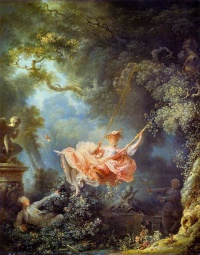Suspenders

Contents[hide] |
Historical development
Early evolution
According to a number of online sources, the evolution of the garter can be traced back as far as the medieval period, when laces and ribbons were employed to hold up woolen knee-socks. A unisex restraint used by both males and females, the band was usually tied around the top of the calf to prevent the hose slipping down to the ankle. More elaborate designs appeared with the passage of time, culminating in the ornate leg-garter of the Rococo era, by which point the garment had gained wide popularity amongst fashionable young women. Fragonard's L'escarpolette clearly exhibits the sexual aspects of both the silk stocking and the inner thigh.
The modern suspender belt seems to have developed during the early 1800s, as European women adopted pantalettes as the standard feminine undergarment. With lighter materials allowing more intricate designs, knickers and hosiery took on an increasingly florid appearance, leading to a variety of styles, including bloomers, tap pants, camisoles and (eventually) briefs. The first suspender belt was an extension of the corset, in which the stockings were attached via longline straps. Knee-length pantaloons were initially worn beneath the harness to provide both warmth and modesty, though convenience soon dictated the wearing of short-legged pants over the maidenform.
The rise of La Belle Époque signaled a revolution in womens' underfashions. With showgirls and entertainers revealing progressively more of their figures throughout the late 1800s, knickers receded and suspenders lengthened to display most of the inner thigh. Following trends set by headline performers of the time, whale-bone corsets gave way to the garter belt around the turn of the century.
A wide variety of social historians have confirmed that the cancan exerted considerable influence over both the clothing industry and the suffrage movement prior to The Great War. After La Chahut was exported to Britain and the United States, the demand for mass-produced lingerie increased, spurred on by the controversy surrounding the "French Scandal". Suspender stockings became an essential part of the basic wardrobe, with manufacturers rushing to fill the newly opened market. In many cases, the Cancan was seen as an act of rebellion against the restrictions of Victorian society, and many early feminists adopted the liberal attitudes promoted by the dance.
World War Two
Suspenders became a common, popular alternative to the girdle during the war, particularly among teens and young women. Amid concerns that girdles might cause abdominal problems, garter belts offered a simpler, more practical, and more comfortable choice when used only to hold up stockings. During WW-II, WAAFs were issued inexpensive suspenders, most probably due to wartime rationing. The practice continued well into the late fifties, at which point tights and panty hose began to dominate the market.
For everyday wear, many women wore stockings without suspenders by simply rolling the top of the stocking, because it was more practical, thus creating a kind of ancestor of the modern hold ups.
Suspenders continue to be worn for their original purpose of holding up stockings, though the modern variants are available in a variety of styles, with red or black satin made from a mixture of nylon and spandex being the most popular.
Depiction in art and photography
Some men's magazines, such as Spick and Span magazine, featured models in suspenders and stockings, sometimes with slips or petticoats.
Since the early 1960s, when men's magazines featured images of women in underwear, they have acquired an erotic element and are often presented as fetish clothing and in pornography. Variations of the garter include panties with suspender attachments reminiscent of images of the 1960s, and corsets with small loops inside the bottom edge for attaching suspenders.
See also
| |
This page uses content from Wikipedia; the original article can be viewed here. |

